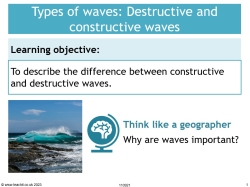Types of waves: Destructive and constructive waves

Use this complete PowerPoint lesson and worksheet to teach students about the two types of waves.
Students will learn how to identify constructive and destructive waves, describe and explain their characteristics and start to recognize the relationship between types of waves and coastal processes.
What’s included?
Activities in this resource include an introductory video clip, with questions to test understanding, a fill-in-the-blanks activity, a ‘draw like a geographer’ diagram activity, a ‘wave expert challenge’ sorting wave characteristics into the correct categories and an exam-style question.
The resource includes a PowerPoint with all activity instructions and answers, plus a printable worksheet for completing the activities.
How to use this resource
This resource can be used for KS3 and GCSE students and makes a great introduction to coastal processes and coastal landscapes.
For more like this, explore the full Coasts resource collection, including teaching materials on case studies, landforms, coastal management and more.
Sample questions on types of waves:
What is the fetch of a wave?
Water breaking up onto the beach is called the…
Water flowing back to the sea is called the…
What process carries material up the beach?
What type of waves has a more powerful swash than backwash?
What type of beach profile is produced by a constructive wave?
What type of waves has a more powerful backwash than swash?
Which type of wave is generally higher?
Which process transports sediment down the coast?
